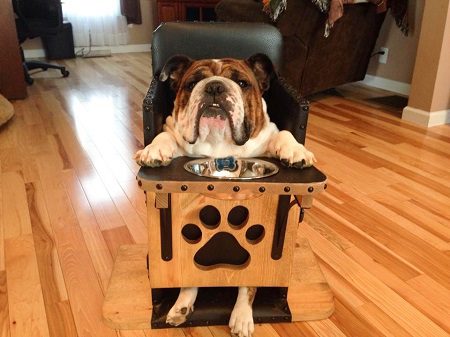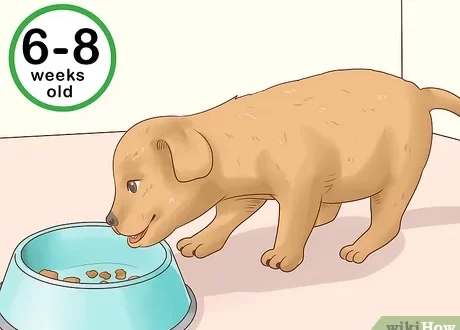
Megasophagus šunims: simptomai, gydymas ir kontrolė
The sight of a dog eating upright in a special high chair may seem strange to the untrained eye, but owners of dogs with megaesophagus syndrome know that this is not just a social media stunt. This is a daily necessity.
Some breeds are born with a condition that makes it difficult to digest food if they are not eating in an upright position. Megaesophagus in dogs can be controlled with a special diet and, in some rare cases, surgery.
Turinys
What is megaesophagus in dogs
Normally, after swallowing, a muscular tube called the esophagus moves food from the dog’s mouth to the stomach for digestion. With megaesophagus, a pet cannot swallow food normally because their esophagus lacks the muscle tone and mobility to move food and water. Instead, her esophagus expands, and food accumulates in its lower part without entering the stomach. Therefore, the dog regurgitates food immediately after eating.
This disease is congenital, that is, it is present in some dogs at the time of birth. Megaesophagus is the main reason why a dog burps after eating and is an inherited condition in Miniature Schnauzers and Wire Fox Terriers, Newfoundlands, German Shepherds, Labrador Retrievers, Irish Setters, Sharpeis and Greyhounds.
This condition can also develop in the presence of other diseases, such as neurological or hormonal disorders, as well as trauma to the nervous system, blockage of the esophagus, severe inflammation of the esophagus, or exposure to toxins.
Unfortunately, in many cases, the cause of the development of this syndrome remains unidentified..
Megaesophagus simptomai šunims
The main sign of megaesophagus in dogs is regurgitation of food shortly after eating. It should be noted that regurgitation is not vomiting. Vomiting is usually accompanied by loud gagging due to the fact that the mass leaves the stomach or small intestine. When regurgitation occurs, food, water, and saliva are ejected directly from the esophagus without tension in the abdominal muscles and usually without any warning signs.
Other signs include weight loss in spite of a brutal appetite, stunting in puppies, excessive salivation, or bad breath.
Dogs with megaesophagus syndrome are at risk of aspiration of regurgitated food into the lungs and development of aspiration pneumonia. Signs of aspiration pneumonia include cough, nasal discharge, fever, poor appetite, and lethargy.
If your dog shows any of these signs, you should urgently make an appointment with your veterinarian for further evaluation.
Megasophagus diagnozė šunims
Both megaesophagus and aspiration pneumonia are commonly seen on a chest x-ray. There are no specific blood tests for megaesophagus, but your veterinarian may order additional tests. They will help determine if the condition is secondary to another disease. This may require an endoscopy of the esophagus.
Endoscopy is the insertion of a thin tube with a camera at the end into the esophagus to check for abnormalities. This procedure is prescribed for narrowing of the lumen of the esophagus, tumors or stuck foreign bodies. In dogs, it is performed under anesthesia, but in most cases, the pet will be able to return home the same day.
If the primary disease is treatable and intervention is performed early enough, esophageal motility can recover and the megaesophagus regresses. However, in many cases, megaesophagus is a lifelong disease that needs to be controlled.
Monitoring and feeding a dog with megaesophagus
The main approach in controlling megaesophagus in dogs is to prevent aspiration and allow food to enter the stomach. Dogs with this disease are often underweight and may require a high-calorie diet, which is best provided with wet or canned food.
Rolling such soft food into bite-sized meatballs can stimulate the pet’s esophagus to contract and move solid food. A therapeutic diet can be a good option for four-legged friends with megaesophagus. It is important to discuss this with your veterinarian to find out which diet is right for your pet.
In this case, the pet should be fed in an upright position, at an angle of 45 to 90 degrees to the floor – this is where high chairs come in handy. The Bailey chair, or megaesophagus dog chair, provides them with support in an upright position while feeding.
If the disease occurs in a moderate form in a pet, it is likely that you will not have to buy a special chair. However, food bowls must be placed on a raised platform so that the dog does not have to bend over at all while eating..
In a severe form of the disease, the dog’s esophagus is not at all able to push food into the stomach. In such cases, your veterinarian may insert a permanent gastric tube completely around the esophagus. Gastric tubes are generally well tolerated by dogs and are generally easy to maintain.
It is very important to monitor a four-legged friend with megaesophagus daily for any signs of life-threatening aspiration pneumonia, including difficulty breathing, fever, and rapid heart rate. Aspiration pneumonia and malnutrition are the leading causes of death in dogs with megaesophagus syndrome. If a pet is diagnosed with this syndrome, be sure to weigh it every week and check daily for signs of aspiration pneumonia.
Although megaesophagus can create some problems, it does not necessarily have to affect the pet’s quality of life. With proper supervision, monitoring and close cooperation with a veterinarian, many owners manage to provide their dogs with a completely normal life.





